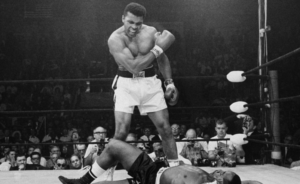Introduction

In the realm of combat sports, few can rival the rich and multifaceted history of boxing. Often referred to as “the sweet science,” boxing’s roots stretch deep into the annals of human history. From the bloodstained sands of ancient Greece to the global spotlight of Madison Square Garden, boxing has evolved, adapting and transforming into a magnificent sport that transcends borders and time. In this comprehensive exploration, we will delve deeply into the mesmerizing History of Boxing , charting its intriguing origins, transformative eras, and enduring allure as a supreme test of physical and mental prowess.
Ancient Beginnings
The birth of boxing can be traced back to the ancient civilizations, where the Greeks, ever inclined toward competition. As far back as 688 B.C., boxing was included as a staple event in the Olympic Games. However, it is essential to note that these early incarnations of the sport bore little resemblance to today’s organized, rules-bound contests. Instead, ancient pugilists wielded leather straps adorned with metal or sharpened edges, with a singular, brutal aim – to render their adversary incapacitated. In stark contrast to the modern ruleset, these early bouts unfolded as savage spectacles, brimming with an uncaged, primal energy.
The Emergence of Modern Boxing
The metamorphosis of boxing from this ancient brutality into a structured, regulated sport occurred during the 18th century in England. A pivotal moment in this transformation was marked by the establishment of the London Prize Ring Rules in 1838. These rules introduced significant innovations, including the use of padded gloves, a defined boxing ring, and the concept of rounds. Boxing was in the throes of evolution, shifting from a raw, unfettered spectacle into a refined, organized activity.
The Marquess of Queensberry Rules
However, it was the advent of the Marquess of Queensberry Rules in 1867 that marked a veritable revolution in the sport. These rules catalyzed a shift towards the modern form of boxing as we know it today. Notably, the introduction of gloves, the prohibition of wrestling and clinching, and the division of bouts into three-minute rounds punctuated by one-minute intermissions injected a new level of safety and competitiveness into the sport.
Era of Gloved Champions
The late 19th and early 20th centuries saw a meteoric rise in the popularity of boxing. Iconic figures such as John L. Sullivan, Jack Dempsey, and Gene Tunney became veritable household names, especially in the glamorous heavyweight division. These warriors earned the esteemed title of “World Champion,” and their exploits captured the imaginations of people across the globe. Boxing had transcended sport to become a compelling narrative of human triumph and tenacity.
Globalization of Boxing
As the 20th century dawned, boxing’s eminence continued to swell, reaching corners of the world. Eminent fighters like Joe Louis, Sugar Ray Robinson, and Muhammad Ali evolved into international symbols of the sport. The concept of national and regional boundaries could no longer contain the ceaseless surge of boxing. The sweet science had become a global phenomenon, heralding a universal appeal.
The Pay-Per-View Epoch
The latter half of the 20th century ushered in an era dominated by pay-per-view boxing. Fighters like Mike Tyson and Evander Holyfield commanded colossal audiences and commensurate paychecks. Boxing matches evolved into iconic events that captivated and polarized viewers worldwide. The sport had indeed transgressed being merely a spectacle; it had become an integral part of the global zeitgeist. The fervent rivalries and epic battles etched indelible marks on history.
The Contemporary Era
The 21st century has borne witness to the continued flourishing of boxing. Modern champions, including the likes of Floyd Mayweather Jr. and Manny Pacquiao, have upheld the sport’s legacy of greatness. The introduction of new weight classes and governing bodies has further diversified the talent pool . Boxing remains a platform for athletes to display their unwavering courage, honed skills, and indomitable determination on an international stage, captivating fans spanning generations and backgrounds.
The Timeless Allure
What is it that underpins boxing’s enduring appeal, ensuring its longevity through the centuries? It could be the inherent simplicity of pitting two individuals against each other, challenging their physical and mental limits within a controlled yet merciless arena. It’s a sport where discipline, bravery, and strategy reign supreme, where fighters must wield tactics alongside physical prowess. Boxing instills values of respect, humility, and the importance of relentless labor, not just within the ring but as life’s broader metaphors. It is the ultimate crucible for character , where adversity is met with unwavering resolve, making it a sport that resonates not just within the arena but within the human spirit.
Also Read :
Conclusion : History of Boxing
The history of boxing stands as a testament to the sport’s enduring legacy, a saga of adaptation and evolution that spans the annals of time. From its primal origins in ancient Greece to the meticulously regulated modern form, boxing has transcended the limitations of epochs and geographies. It continues to inspire fighters and enrapture fans, serving as a powerful metaphor for life’s relentless struggles and the human spirit’s unyielding determination. In the world of boxing, every fighter’s journey is a testament to the indomitable will, making it a sport that will forever carve its place within the tapestry of history and in the hearts of humankind.




